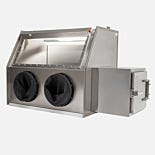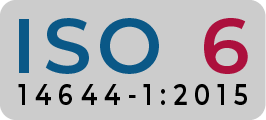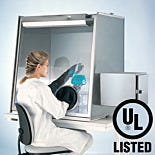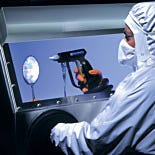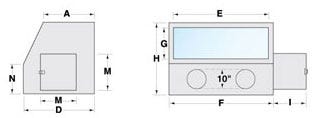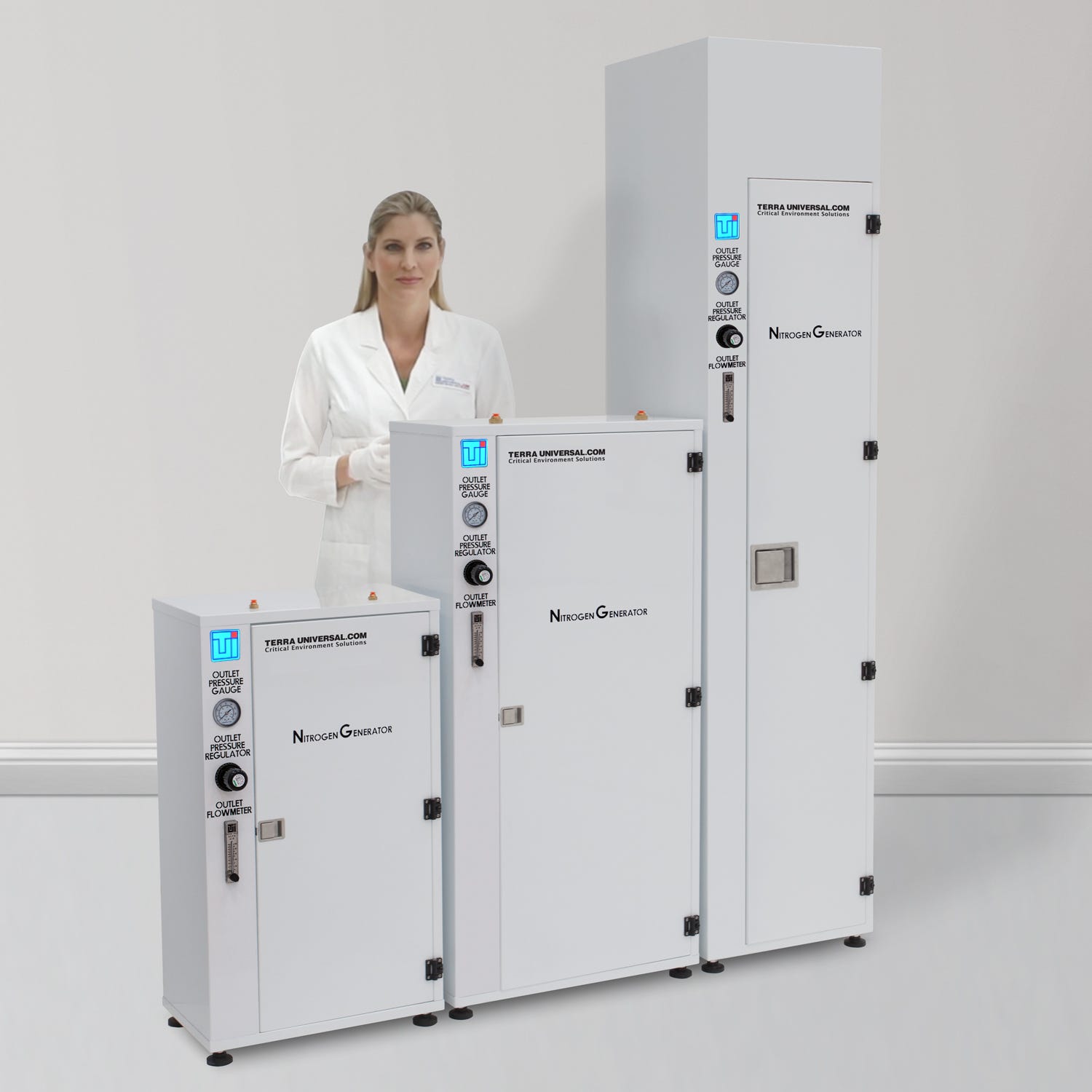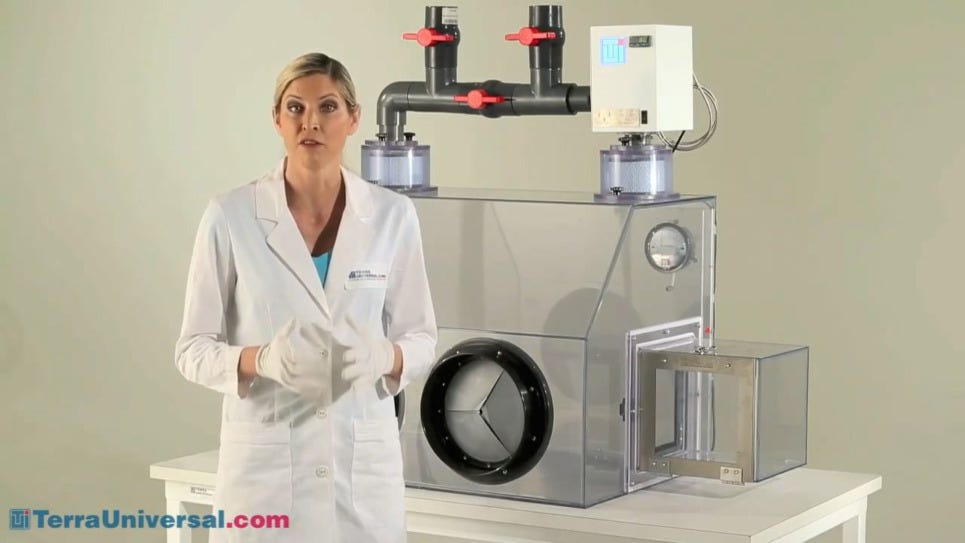Stainless Steel Glove Box Applications
Inert Gas Processing and Seam Welding Glove Box Isolator


Application Requirements:
- Temperature: Degassing at up to 300°C in pass-through oven
- Humidity: Subambient to 0%RH (± 2% RH)
- Process Gas: 20% He/80%N2 (mixture accurate to 5 ppm)
- Pressure: 0.1" WG
- Access: Accordion sleeve gloves. Air lock for parts removal Quick-Connect bulkheads for welding electrodes
- ESD Safety: Static neutralization in less than 30 sec. (1KV to 100V)
To eliminate embrittlements that result from a high-humidity welding environment, this glove box isolator maintains a dry nitrogen environment with automated humidity controls.
The glove box isolator features a pass-through vacuum/nitrogen oven for degassing at temperatures up to 300°C, and a right-side air lock for easy parts removal. A trace gas mixer provides a precise He/N2 gas mixture during seam welding, which allows for subsequent leak detection in a vacuum chamber. Ionization equipment provides fail-safe static neutralization to protect against ESD in the low-humidity environment.
Sealed quick-connect ports permit easy connection of welding electrodes, and dual service utility outlets are provided for 110/220VAC, 50/60Hz power.
Lithium Battery Electrode Glove Box Isolator


Application Requirements:
- Humidity: <5% RH
- Process Gas: Nitrogen, with trace oxygen monitoring (to 1 ppm)
- Pressure: 0.1" WG
- ESD Safety: Static neutralization in less than 30 sec. (1KV to 100V)
- Access: Air Lock. Dual-side accordian sleeve gloves. RF Sealer enclosure with sealed utility ports.
- Particle Control: Class 1000
This glove box isolator is used for packaging lithium battery electrodes using an RF bag sealer. A humidity control system provides the low-moisture environment required during sealing, and a trace oxygen analyzer helps minimize the chance of oxidation by sensing oxygen levels as low as 1 ppm (v).
The sealed enclosure below the sealing chamber houses the RF sealer. Side ports allow easy connection to an externally mounted RF generator. An air lock allows easy parts transfer. Self-balancing ionizing equipment neutralizes static charges to protect against electro-static discharge (ESD) in the low-humidity environment.
Dry Ice Cleaning Isolator


Application Requirements:
- Humidity: < 1 ppm(v) water vapor
- Process Gas: Nitrogen
- Pressure: 0.1" WG
- Access: Dual-side air locks. Accordian sleeve gloves. Quick-connect ports for SNO GUN. Optional tilt-up window
- ESD Safety: Static neutralization in less than 30 sec. (1KV to 100V)
This isolator is designed specifically for use with the SNO-GUN™ II Dry Ice Cleaning System. By maintaining an extremely dry nitrogen environment, it prevents moisture condensation when very cold liquid CO2 is used as a cleaning medium for sensitive parts.
In addition to nitrogen control systems, which must automatically maintain a very low dew point inside the glove box/isolator, this chamber includes a static neutralizing bar to protect parts against ESD (electrostatic discharge) in the dry environment. Quick-connect ports allow easy connection of the SNO GUN to a purified CO2 source.
Carbon Monoxide Sensor Calibration Glove Box
Application Requirements:
- Temperature: Stable, ± 1°F (±18°C) for 30 min. HOLD temperatures at 68°F and 120°F (20°C and 49°C)
- Humidity: Ambient to 95% RH
- Process Gas: 2% CO/95% air mixture
- Pressure: On-demand emergency ventilation (chamber environment purged in less than 20 seconds)
- Access: Pneumatic access door (externally activated) with trolley conveyor Neoprene gloves
In this application, potentially lethal CO gas is fed into a large chamber at precise concentrations to allow accurate sensor calibration.
A gas mixing system maintains a ratio of 2% CO/98% air during calibration. To meet requirements for high-humidity sensor performance, a Humex™ humidifier raises the moisture level inside the chamber to 95% RH. A process gas heater and cooler provide two precise calibration temperatures: 68°F and 120°F. Circulation fans ensure uniform temperature and humidity throughout the main chamber.
Upon completion of calibration, an emergency ventilation system evacuates the CO/air mixtures from the main chamber and air locks through an exhaust line plumbed vertically to the facility ceiling. The 740 CFM (1257 m³/hr) fan requires less than 20 seconds to reduce the CO concentration to safe levels.
Because the large chamber size precludes easy access to the air lock, sensors are loaded and unloaded on a trolley conveyor. The air lock pneumatic doors are opened and closed by means of an easy-access control mounted outside the chamber.


Full-View Toxic Chemical Repackaging Glove Box
Application Requirements:
- Pressure: Negative pressure to 2" WG (main chamber)
- Access: Neoprene gloves. Rapid-access sliding side doors. 8" x 12" (203 mm x 305 mm) disposal trap door
This 304 stainless steel containment chamber features dual-side static-dissipative PVC viewing windows. It is used for repackaging toxic chemical solids, mounted on a 3" (76 mm)-diameter mandrel, for subsequent disposal.
Side doors slide open to allow insertion of the support mandrel, which contains one or two chemical containers. Doors then slide shut to seal around the mandrel. A constant negative pressure inside the isolation chamber, generated by a remote ventilation system, draws fumes into an exhaust line in the chamber ceiling. This exhaust system protects operators as they repackage the chemical solids in disposal containers. Pressure safety valves ensure that negative pressure remains below 2" WG, protecting chamber and glove seals.
Disposal containers are removed from the chamber through a trap door on the chamber floor, and the side doors are then reopened to allow removal of the mandrel.


Can't find what you're looking for?Tell us what you need and we'll build it!




